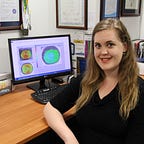Magic? No, it’s orthokeratology!
Myopia (short-sightedness) has been recognised as one of the five leading causes of blindness and visual impairments in the world by the World Health Organisation. Research shows there are a number of options to slow myopia progression, and thus reduce the associated increased eye health risks including glaucoma, macular degeneration and retinal detachment. One of these is overnight Orthokeratology, often referred to as OrthoK. Although most of us are familiar with spectacles and daytime wear contact lenses, I often get asked in practice what is OrthoK? Is it true that I can see clearly through the day with no daytime correction?! The answer is yes!
I absolutely love seeing the great, big smile on a child’s face after a week of wearing OrthoK lenses and their excitement (and their parents!) of reading many more lines down the vision chart. My first experience with OrthoK was in high school when my mum was fitted with these lenses to correct her myopia, and I am just as excited now about OrthoK as I was back then!
So, what is OrthoK?
OrthoK are custom-made rigid lenses that are worn overnight. They gently reshape the cornea (the clear dome at the front of the eye) so that you can see clearly during the day without the need for glasses or contact lenses. This provides lifestyle benefits, particularly for active children and adults, sports and recreational activities. The corneal reshaping is reversible. Thus if you stop wearing the OrthoK lenses, your eye shape and prescription will return to its pre OrthoK baseline. It is also an alternative to LASIK or other refractive surgery for adults. There is some awareness of the OrthoK lens on eye initially when applied and there is generally very good adaptation and comfort. It can be worn to correct vision in children and adults.
How does Orthok slow myopia progression?
OrthoK lenses in myopia correction are designed with a flatter central curve; creating a positive pressure centrally and a negative pulling pressure in the mid-periphery of the cornea. This redistributes the cells in the front layer of the cornea to the mid-periphery, creating a transient volcano-like shaped treatment — flatter in the centre and steeper in the mid-periphery. Don’t worry, we can only see this ‘volcano’ shape when measured on our instruments, not with the naked eye, and you can’t feel the shape underneath your eyelids either!
The corneal reshaping allows light-rays to focus accurately on the centre and mid-periphery of the retina (the light sensitive ‘film’ layer at the back of the eye), providing clear vision. The defocus of the peripheral light in the eye is theorised to slow myopia progression and stabilise eye growth. The effect of OrthoK in changing eye muscle coordination, particularly near binocular vision postures shown to be risk factors for myopic progression is another suggested hypothesis for its proven effect in slowing myopia progression.
Is my prescription suitable for OrthoK?
OrthoK can be used to correct myopia (short-sightedness), hyperopia (long-sightedness), astigmatism and presbyopia (blurred near vision that commences when we reach our 40s). To assess if you are a good candidate, your optometrist will map the front surface of your eye with an instrument called a topographer. Similar to geographical topography showing the hills, valleys and physical shape of the landscape, this corneal map will indicate whether the shape of your eye combined with your prescription will provide clear vision from the OrthoK. It is also used to custom-make the OrthoK lens for your eye shape. As described above, due to the central flattening in myopia OrthoK correction, a naturally very flat cornea and/or higher prescriptions can be more difficult to achieve full refractive correction. However for myopia control purposes, there is research indicating that even partial myopia correction with OrthoK (and the remaining prescription corrected with glasses) can slow myopia progression and eyeball length growth in children.
Is it safe?
Research shows that OrthoK is a safe treatment for correcting vision and use in myopia control. OrthoK was FDA approved in 2002 by the United States of America Food and Drug Administration, however it has been available for much longer.
There is a small risk of a serious eye infection with any type of contact lens wear. Research indicates that the estimated incidence is 7.7 per 10,000 years of lens wear. Generally your eye care practitioner will treat an eye infection with prescription medication drops.
Parents often ask whether OrthoK is safe for children. Research shows that there is actually decreased risks of inflammatory conditions in children aged 8–15 years, compared with teenagers and adults. Each child is different though and parents, practitioners and the child can determine together if it is appropriate. The risks of adverse events are reduced by strictly following the cleaning and maintenance practices that your optometrist discusses with you and attending regular eye examinations.
Where do I find an eye care practitioner that fits OrthoK?
Just over 1% of optometrists worldwide fit Orthokeratology lenses. You can find your local practitioner in Australia and New Zealand by searching on http://www.oso.net.au/where-do-i-get-it, or if you’re located in another part of the world search on https://www.orthokacademy.com/find-an-ortho-k-doctor2/ or https://www.eurok.eu/practitioners.
